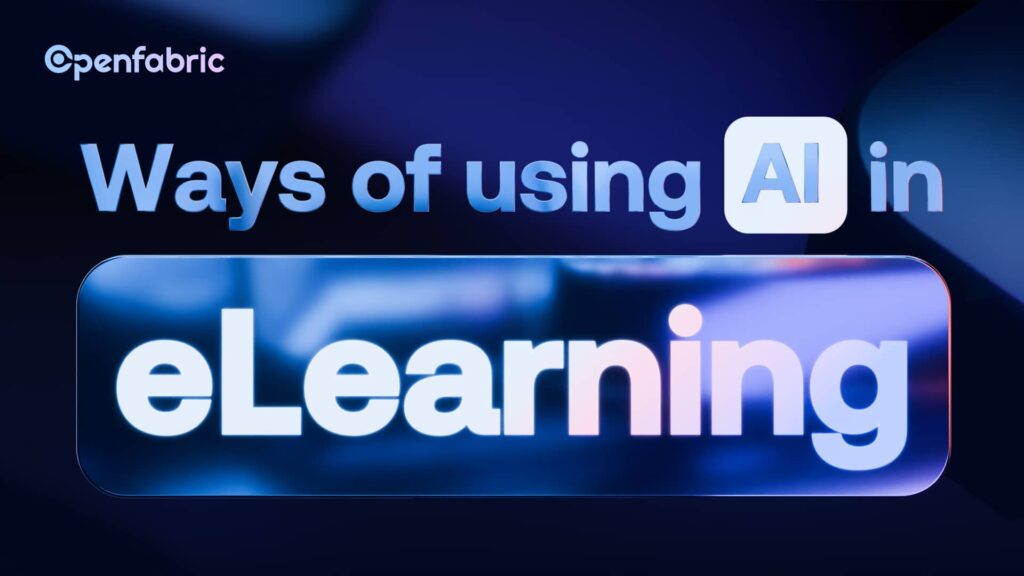
August 2, 2024 7 minutes read
Ways of Using AI in eLearning

E-learning is a type of learning that primarily utilizes the internet as the medium for learning. This method of learning was introduced in 1999 and has since become increasingly popular. However, these days it goes by terms such as internet learning and virtual learning which accurately describes it. With AI in eLearning that too is about to change.
The advent of Artificial Intelligence (AI) has revolutionized numerous industries, and education is no exception. AI’s transformative power is reshaping the eLearning landscape, offering unmatched academic outcomes. As technology continues to advance, AI’s role in eLearning is becoming increasingly vital, enabling educators to create effective learning experiences.
The traditional one-size-fits-all approach to education often falls short in catering to individual students’ needs, learning styles, and abilities. AI, on the other hand, addresses this limitation.
As we delve into learning more about AI in eLearning, we will see that the technology’s potential extends far beyond automation alone. AI is transforming the very fabric of education, enabling a more inclusive, accessible, and effective learning experience.
In this blog post, we will explore the top 6 ways AI is revolutionizing eLearning and uncover the exciting possibilities that lie ahead for the future of education.
Let’s get started.
How to use AI in eLearning and current use cases
These are the major ways we can use AI in eLearning to foster a better learning experience and give good outcomes.
Using personalized learning models
The traditional classroom model often struggles to accommodate the diverse needs and abilities of students. However, with AI-powered personalized learning paths, students are provided with tailored educational models that cater to each of their unique requirements or needs.
AI-powered eLearning leverages machine learning algorithms and data analytics to:
- Assess individual learning styles, strengths, and weaknesses.
- Identify knowledge gaps and skill deficiencies.
- Create customized learning plans with adaptive content and resources.
- Continuously monitor progress and adjust the learning path accordingly.
Use cases: Platforms like DreamBox, Curriculum Associates, and Knewton are already harnessing AI to deliver personalized learning experiences. This demonstrates the vast potential of this approach in revolutionizing eLearning.
Leveraging AI-powered assessments
Many times, traditional assessments often fall short in providing accurate and timely feedback. Thus, they rely on periodic exams and standardized tests.
However, with AI-powered adaptive assessments, we can offer real-time insights, personalized feedback, and data-driven instruction.
This might beg the question, ‘how can it be done?’ Using AI in eLearning can:
- Continuously assess student knowledge and skills
- Adjust difficulty levels and content in real-time
- Identify knowledge gaps and areas of improvement
- Provide immediate feedback and recommendations
- Enable teachers to track progress and adjust instruction
Use cases: Platforms like Knewton, Pearson, and McGraw-Hill are top pioneers of AI-powered adaptive assessments. They are empowering educators to make data-driven decisions, and students to take control of their learning journey.
Providing one-on-one support for students
AI-powered Intelligent Tutoring Systems (ITS) provide personalized guidance and support for students. Platforms that use such systems can simulate one-on-one interactions between students and experienced teachers.
ITS platforms are crucial especially when it comes to catering for students with special needs. In general, they revolutionize eLearning by:
- Offering real-time feedback and guidance
- Adapting to individual learning needs and styles
- Providing interactive learning experiences
- Facilitating self-paced learning and exploration
Use cases: Platforms like Carnegie Learning’s Cognitive Tutor, Pearson’s ALEKS, and McGraw-Hill’s Connect leverage AI in eLearning by integrating ITS into their algorithm.
Automating administrative tasks
There are a ton of administrative tasks that are crucial to keep schools and learning platforms going. Such tasks are time-consuming and strenuous for the administrative staff especially when they also teach.
However, AI in eLearning can automate administrative tasks, leaving instructors to focus solely on teaching and mentoring. Hence, AI-powered tools can:
- Grade assignments and exams
- Track student progress and attendance
- Develop personalized learning plans
- Enhance data analysis and visualization
In turn, by automating administrative tasks, educators:
- Increase efficiency and productivity
- Reduce workload and stress
- Improve student outcomes and academic achievement
Use cases: Platforms like Gradescope, Turnitin, and Canvas are already leveraging AI to streamline education, enabling instructors to devote more time to teaching and supporting students.
Enhancing student engagement through gamification and interactive content
Using AI in eLearning allows us to leverage gamification and interactive content which helps to transform the learning experience, and increase student engagement and motivation.
How AI does this is by:
- Creating personalized learning games and activities
- Adapting difficulty levels and content in real-time
- Providing instant feedback and rewards
- Creating a sense of community and competition
The result is evident and measurable in that there is a simultaneous increase in student participation and the development of problem-solving skills.
Use cases: We can already see this innovation on eLearning platforms like Duolingo, Coursera, and Udemy.
Using AI in eLearning for predictive analytics
In learning, no two learning abilities are the same. That is why it is important for a teacher to be able to identify a student’s knowledge gaps and further make recommendations or give instructions to rectify this challenge. However, unaided, this can be an extremely difficult situation.
Thus, by harnessing AI’s ability to make predictive analysis, teachers can identify knowledge gaps, and create solutions to solve this problem.
This leads to an overall enhancement of a student’s performance and the teacher’s effectiveness.
Use cases: Platforms like BrightBytes, Renaissance, and DreamBox use AI’s predictive analytics, to empower educators to make data-driven decisions and improve learning outcomes.
Benefits of AI in eLearning
- Personalized Learning: using AI in eLearning helps tailor education to individual students’ needs, abilities, and learning styles. It analyzes students’ data, identifies knowledge gaps and skill deficiencies, and adjusts the learning path accordingly.
- Improved student engagement: through AI-powered gamification, interactive content, and adaptive assessments there can be an increase in student participation and motivation.
- Improved academic outcomes: using AI in eLearning helps to improve knowledge retention, recall, and application. The AI-driven adaptive assessments and real-time feedback help students identify areas for improvement, which in turn leads to better academic performance.
- Increased efficiency: because AI automates administrative tasks, instructors can focus on teaching and mentoring. This helps to reduce their workload.
- Data-driven decision-making: AI provides valuable insights, enabling educators to make informed decisions.
- Accessibility and inclusion: using AI in eLearning supports students with special needs or in remote or underserved communities. Therefore AI helps to provide equal access to education, regardless of geographical location or ability.
- Scalability and Flexibility: AI facilitates self-paced learning, anytime, anywhere. AI-powered platforms enable students to learn at their own pace, on their own schedule.
- Teacher support and enhancement: AI-powered learning assists instructors in identifying knowledge gaps, and developing personalized learning plans. Therefore, it augments instructor capabilities, reducing workload and stress.
What is the relevance of Openfabric AI in eLearning?
Being the Internet of AI Technology, Openfabric AI has created numerous tools that can foster eLearning. It is a platform that enables the development and deployment of AI models in various industries, including education.
Openfabric AI provides a framework for creating and implementing AI-powered solutions in online learning environments.
In eLearning, OpenFabric AI can help in:
- Personalized learning: By analyzing student data and behavior, Openfabric AI can aid in tailoring learning experiences to individual needs.
- Intelligent tutoring systems: Openfabric AI can support the development of AI-driven tutoring systems that offer real-time guidance and feedback.
- Content creation: Openfabric AI can assist in generating educational content, such as quizzes, assessments, and interactive materials.
- Natural Language Processing (NLP): Openfabric AI’s NLP capabilities can enhance language learning, sentiment analysis, and text-based interactions in eLearning platforms.
What are the Openfabric AI tools used in eLearning?
Openfabric 3D Model Generator V2
This tool can generate 3D models that can be used as visual aids on eLearning platforms. These 3D models can also be generated via a printer for a closer and physical assessment by the student.
Most importantly, it is very easy to use as it creates accurate 3D models for use by using text prompts.
Artfabric AI App
This can be used to create an online learning environment that is more immersive and personalized. It can also create learning materials that can serve as great visual aids to the students.
Chat with Documents App
This application can enhance eLearning in that it makes looking for information easier. With the integration of NLP, you can easily look for a particular information on a document instead of having to go through the whole document.
This makes learning easier, faster and more efficient.
Openfabric AI platform will see more AI apps that will completely revolutionize the education sector. For more information and updates, visit our website.
Conclusion
The integration of Artificial Intelligence in eLearning will continue to revolutionize the educational landscape. At the forefront of pioneering technologies driving this revolution is Openfabric AI.
As we’ve explored in this article, we must remember that AI is not a replacement for human instructors. Contrarily, it is a powerful tool to augment and enhance their capabilities. Embracing AI-powered solutions can help us create a more inclusive, effective, and engaging education system.

